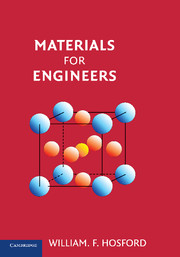Book contents
- Frontmatter
- Contents
- Preface
- 1 Introduction
- 2 Phases
- 3 Diffusion
- 4 Mechanical Behavior
- 5 Mechanical Failure
- 6 Annealing
- 7 Iron and Steel
- 8 Nonferrous Metals
- 9 Casting and Welding
- 10 Solid Shaping
- 11 Polymers
- 12 Polymer Processing
- 13 Glasses
- 14 Crystalline Ceramics
- 15 Powder Processing
- 16 Pottery and Concrete
- 17 Composites
- 18 Carbon
- 19 Fibers, Foams, and Porous Materials
- 20 Electrical Properties
- 21 Optical and Thermal Properties
- 22 Magnetic Materials
- 23 Corrosion
- 24 Modern Manufacturing Techniques, Surface Treatments, and Recycling
- APPENDIX 1 Wood
- APPENDIX 2 Miller Indices for Planes and Directions
- APPENDIX 3 X-ray Diffraction
- APPENDIX 4 Surfaces
- APPENDIX 5 Dislocations
- APPENDIX 6 Avrami Kinetics
- APPENDIX 7 Organic Chemistry
- APPENDIX 8 Average Molecular Weight
- APPENDIX 9 Bond Geometry in Compounds
- APPENDIX 10 Weibull Analysis
- Index
- Conversions
2 - Phases
Published online by Cambridge University Press: 05 June 2012
- Frontmatter
- Contents
- Preface
- 1 Introduction
- 2 Phases
- 3 Diffusion
- 4 Mechanical Behavior
- 5 Mechanical Failure
- 6 Annealing
- 7 Iron and Steel
- 8 Nonferrous Metals
- 9 Casting and Welding
- 10 Solid Shaping
- 11 Polymers
- 12 Polymer Processing
- 13 Glasses
- 14 Crystalline Ceramics
- 15 Powder Processing
- 16 Pottery and Concrete
- 17 Composites
- 18 Carbon
- 19 Fibers, Foams, and Porous Materials
- 20 Electrical Properties
- 21 Optical and Thermal Properties
- 22 Magnetic Materials
- 23 Corrosion
- 24 Modern Manufacturing Techniques, Surface Treatments, and Recycling
- APPENDIX 1 Wood
- APPENDIX 2 Miller Indices for Planes and Directions
- APPENDIX 3 X-ray Diffraction
- APPENDIX 4 Surfaces
- APPENDIX 5 Dislocations
- APPENDIX 6 Avrami Kinetics
- APPENDIX 7 Organic Chemistry
- APPENDIX 8 Average Molecular Weight
- APPENDIX 9 Bond Geometry in Compounds
- APPENDIX 10 Weibull Analysis
- Index
- Conversions
Summary
What Is a Phase?
A phase is a state of aggregation of matter that has a distinctive structure. Phases may be solid, liquid, or gaseous. A phase may be a pure material or a solution of several components. A solid phase is either amorphous or has a characteristic crystal structure and definite composition range. A physical system may contain more than one solid phase with different crystal structures, or different ranges of possible compositions – one or more mutually insoluble liquid phases (for example oil and water) and a gas phase. All gasses are mutually soluble, and therefore only one gaseous phase is possible.
Single-phase materials include brass (a solid solution of zinc in copper with zinc atoms occupying lattice sites), sodium chloride crystals, glass, and polyethylene. Most plain carbon steels are two-phase materials, consisting of an iron-rich solid solution and iron carbide. A glass of ice water consists of two phases: liquid water and ice. In a glass of tonic water there may be three phases: liquid, ice, and gas bubbles.
The composition of a single phase may vary from place to place, but composition change is always gradual and without abrupt changes. In multiple-phase systems, however, there are discontinuities of composition and structure at phase boundaries. The compositions on each side of the boundary are usually in equilibrium. For example, the oxygen concentration changes abruptly between copper with some oxygen dissolved in it and copper oxide.
- Type
- Chapter
- Information
- Materials for Engineers , pp. 8 - 17Publisher: Cambridge University PressPrint publication year: 2008



